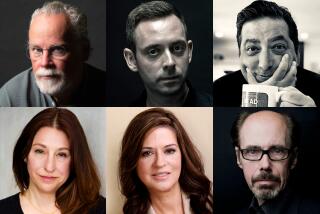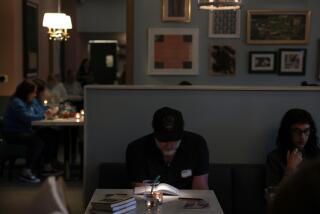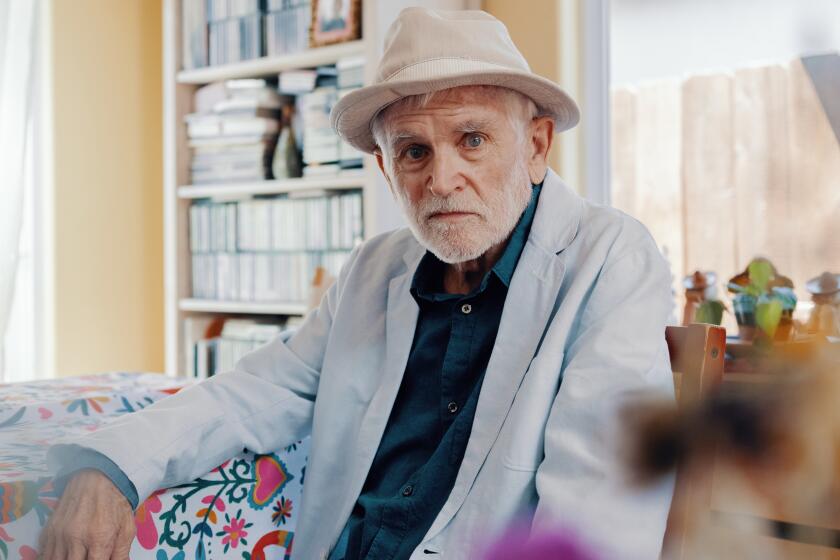READING IN THE DARK.<i> By Seamus Deane</i> .<i> Alfred A. Knopf: 272 pp., $23</i>
- Share via
It begins, puzzlingly, with a series of disconnected childhood memories from the 1940s in Derry, in Northern Ireland. The little boy’s mother senses an invisible presence on the stair’s landing and sobs inconsolably. An aunt tells a terribly frightening ghost story of a brother and sister who drive their nanny mad by exchanging features--hair, eyes, smile, even gender--with each other.
The kindly, mournful father, a shipyard worker, takes the boy and his brother for a seaside walk and points out a patch of turf overhanging the cliff’s edge that the birds seem to avoid. It is, he says, “the land of the disappeared.”
Less mistily, there is his glimpse of a neighbor run over by a van, a policeman vomiting while getting the body out and, later, the inevitable neighborhood rumor that it was the police who were driving the van. There is a violent standoff between the police and the Catholics on St. Patrick’s Day, and fireworks and booming drums on the Protestant marching days.
There is the rough interrogation of the family after the boy sneaks a pistol out of his father’s bureau and shows it to a friend. There is the mystery of why the father, whose long-vanished brother fought in the IRA, was not arrested for possessing the weapon.
These scenes and others make an initial blur, but it is the blur of a film developing. Gradually it takes on a fearful, unforgettable clarity. Northern Irish poet Seamus Deane devises as a fictional memoir “Reading in the Dark,” the web of legend, secrecy and obsession with betrayal that choked and still chokes the history of his country.
It is the story of a Catholic family and its beleaguered community. It looks back to the 1920s and the beginning of Irish partition and leads up into the 1970s. In a larger sense, it is a story of the intractability of civil division, the crippling, ineradicable energies of defeat and the twin curse of too much remembering and too much silence.
These are devastations, but “Reading in the Dark” evokes them not as rhetoric but as the moth holes and rotted-out pieces in the fabric of one family’s life. We would not be so enthralled and moved if Deane had not evoked the life itself with so much humanity, delicacy and fierce wit. Yeats’ “terrible beauty,” a cliche by now, could have been waiting for this near-magical book to arrive.
The darkest devastation in the family is its secrets. The book begins with ghosts and mysteries as a 6- or 7-year-old might apprehend them. It continues with an obstinate search for answers when the same boy achieves the fearsome lucidity and utter lack of caution of a 12-year-old. The search takes him up to 19 and 20, when, knowing the answers, he begins to know the moral and intellectual ambiguity to which all answers lead.
The family secrets are interlocked. First is that Eddie, the father’s brother, was executed by his IRA companions as an informer back in 1922. The second is that it was the wife’s father--the boy’s grandfather--who ordered the execution. The third is that Eddie was the wrong man; the fourth is the identity of the real informer. The grandfather, dying, blurts these things out as the boy sits with him.
There is a fifth secret and a sixth. But this is enough disclosure, considering the choking urgency a reader shares with the boy as he pieces together other scraps and clues over the next few years.
The damage that half-destroys the mother, a brave and loyal woman, and the father, a man of simplicity and kindness, is not so much the secrets themselves as the fact that he knows only the first of them and she comes to know them all. She cannot bring herself to tell him about the tragic error, her father’s role or the rest of it, out of dread that it will destroy their marriage.
Her compunction condemns her husband to think of his brother as a traitor. Silence is the killer. It sends her into a two-year breakdown from which she never entirely recovers; in him, it nurtures a perpetual, leaching pain. The tragedy is both personal and historical--it leaves us wondering what other reading in the dark is being done at this moment by some 12-year-old in Bosnia, for instance.
The beauty of Deane’s lament--as is true of Frank McCourt’s Irish childhood memoir, “Angela’s Ashes,” a lovely but smaller work--is that it is not told as such. The narrator speaks with all the vitality, the appetite for life and discovery and the pleasurable distractibility of his age. Those news shots of children playing soccer in some bombed-out ruin may spell tragedy, but the thunk of each kick is young nature’s irrepressible high spirits.
Some of the book’s high spirits go to depicting the classes at the boy’s school, taught by priests. They are arrogant and sarcastic; they use wit, wordplay and the unconditional authority they possessed back in the 1950s to prevail over their charges. It is a familiar kind of scene by now, going back at least to the whiplash classroom thundering in Joyce’s “Portrait of the Artist as a Young Man” and reworked by Catholic writers ever since.
There is a difference here. For one thing, the boys are not cowed. They stand their ground and score an occasional point--one, for example, in a wonderfully kinked duel in algebra class and another in religion. It is as if they were enduring tennis instruction from a vastly superior player, victims of verbal smash-shots but growing in their own proficiency. For another thing, the priests are presented with complexity as well as wit.
There is a comic and touching scene in which the director of spiritual studies gives the boy his customary one-on-one sex talk. It is no penitential warning; the lesson is mild, in fact, and expounded in valiantly conscientious detail. The boy, about to meet a girlfriend for a real-life smooch, submits with patronizing glee and skips out as soon as he can. Yet:
“As I ran, I imagined Father Nugent hesitantly closing his door and looking at the armchairs on either side of the fire, now mute and emptied of all confidences in the whitened light of his lamp and the tall windows.”
Deane gives a nuanced portrait, in fact, of the Catholic Church in Northern Ireland at mid-century. Belligerent and constricted, it played a role in both holding together and restraining the minority community. In the book’s most complex and ingenious scene, in fact, the local bishop comes to the rescue of the boy who, through a mischance and the malice of the local police, finds himself labeled as a neighborhood informer. It is a brilliant upending of the police sergeant who engineers the rumor.
Bishop aside, the episode is pivotal. For a week or so, the boy is a pariah, not only among the neighbors but within his own family. The shock sets him on the long path of replacing ghosts and mysteries with truth. It is more than the moment when a child begins to grow up. It is the moment in history when primal myth gives way to the clarity of tragedy.
Over the next half-dozen years, the boy achieves his tragic truth. As he does, there is one more pivot, one that elevates “Reading in the Dark” beyond brilliance. Looking at his mother and father grown old, he realizes that the truth that would ease them would also destroy them. From deliverer of secrets he grows up to become their guardian.
More to Read
Sign up for our Book Club newsletter
Get the latest news, events and more from the Los Angeles Times Book Club, and help us get L.A. reading and talking.
You may occasionally receive promotional content from the Los Angeles Times.






